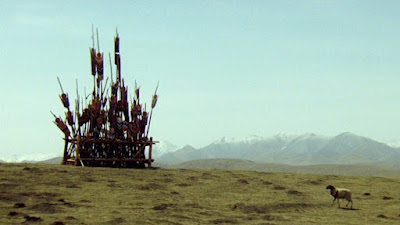The spectacle Tian sets before us is that of both documentary and dream, and what's most fascinating about The Horse Thief is that it never fully tips its hand as to which of these it most wants to be. Instead, we bear awed witness to a film that maps out and then inhabits entirely its own space: it's not just that we're afforded scant clue as to how one sequence relates to another, it's that we have no idea how something this immersively Tibetan, whether fiction, non-fiction or rare alchemy of the two, relates to the Chinese film industry - and, indeed, the Chinese domestic politics - of 1986. What's crucial is that it is immersive, and that the scenes this immersion generates are most often than not remarkable, jawdropping, eyepopping: a papery sacrifice to some mountain god, vultures congregating en masse, a tight-knit circle of bare-chested men burying live sheep in a pit as the winds blow in. No less dazzling are those reds, oranges and greens Tian, co-director Pan Peicheng and cinematographers Hou Yong and Zhao Fei arrive at, which really are as if these colours were being filmed for the first time. (While required viewing for aspirant cinematographers and graders, the film sets a formidably high bar, and also the puzzle of how they got these frames to look like this.) Even as The Horse Thief retreated from wider circulation, many films tried to recreate some aspect of it: Bertolucci's The Last Emperor and Little Buddha, Jean-Jacques Annaud's Seven Years in Tibet, Scorsese's own Kundun, those 21st century ethnographic surveys with titles like The Story of the Weeping Camel. It remains among the foremost examples of the cinema's enduring ability to transport us, to offer the best damn guided tour you've ever been on: certain sequences make Paradjanov look ordinary, and many of these sights will stay with you forever.
The Horse Thief is currently streaming on YouTube.

No comments:
Post a Comment